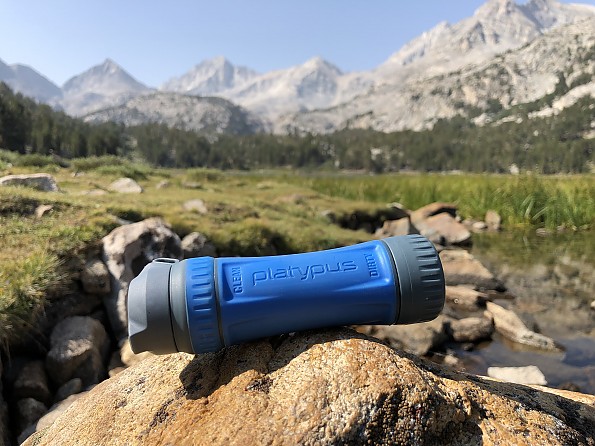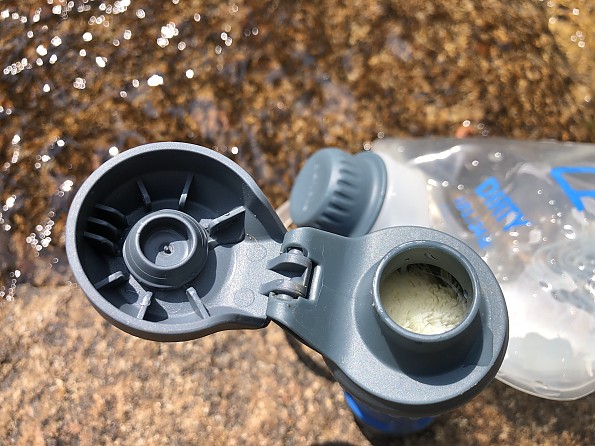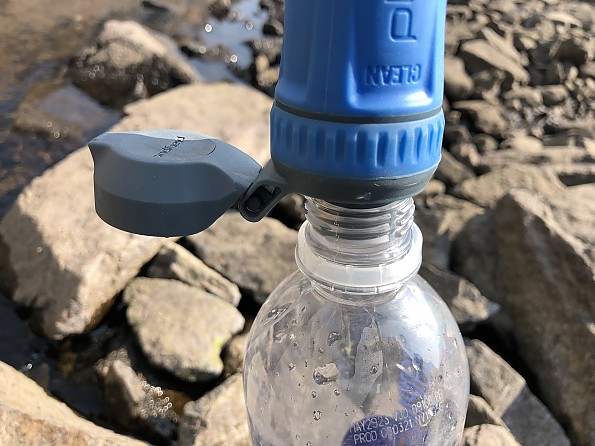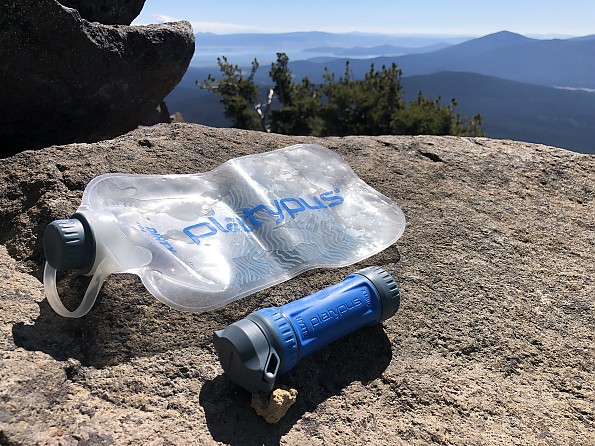Platypus QuickDraw Microfilter System

Without a doubt Platypus has a very clear understanding of what its customers are looking for in a water filter, resulting in the Platypus Quickdraw Microfilter. From my perspective, it is the number one hollow-fiber membrane water filter design available today for solo through hikers or anyone looking to buy their very first water filter.
The well designed Quickdraw Microfilter is a hollow-fiber membrane water filter that takes a few evolutionary steps from an integration and maintenance perspective over other water filters currently available that use similar technology. Every aspect of its design is well thought out, resulting in a filter that performs well, provides multiple interfaces for dirty water containers, and can be maintained in the field without additional special tools.
Pros
- Solid construction and good flow
- Is compatible with Smartwater bottles
- Light
- Good clear instructions
- Clean side cap is attached with long life hinge design
- Materials used have a nice feel/texture—Thermoplastic elastomer
- Cap from filter mates with cap from bag
- Can attach to multiple preexisting bottles
- Waterproof cap designs make it easy to keep in your sleeping bag on a cold night that might damage the filter due to freezing
Cons
- Tight path into filter may trap small debris that won’t easily be cleaned out with shake or backflush method
- Round design can roll away
The Quickdraw Microfilter is a hollow-fiber membrane filter recently introduced by Platypus that from my perspective is the first filter design that really takes into account how these types of filters are actually used and maintained out in the field. While the hollow-fiber membrane used in this filter is not new, each and every feature of this filter is well thought out and delivers a design that reflects how people want to use and maintain a water filter.
The Quickdraw Microfilter is designed to filter out bacteria, protozoa, and particulates larger than 0.2 microns, but is not intended for use to filter out chemicals, toxins, or viruses.
For this evaluation I was provided the Platypus Quickdraw Microfilter System, which consisted of the Quickdraw filter and a one liter Quickdraw Reservoir and I have been using the filter system for a little over two months now
The majority of the time that I have been evaluating the Platypus Quickdraw Microfilter, I have been using the Quickdraw reservoir that came with the filter. However, I also have been using the filter with a Smartwater bottle as a dirty water source and for back flushing to test out various aspects of the filter.

Design Overview and My Impressions to Date
I have now had the Platypus Quickdraw Microfilter for over two and a half months, have been bringing it on all of my regular hikes, and have found it to be an all-around nice filter to use with very few faults.
From a high level perspective the Quickdraw Microfilter is much like most other hollow-fiber membrane water filters in that you attach a container to one end with the dirty water you want to filter, squeeze that container to force the water through the filter, and out comes your clean water from the other end.
Where this filter design starts to stand out compared to other water filters is with each of the specific design details unique to the Quickdraw. For example, while other filter designs use off-the-shelf parts for the closure at the clean water end of the filter, Platypus designed a unique cap and nozzle, as shown in the picture below.

This design is unique in several ways. First and foremost is the large diameter of the nozzle itself which has an inside diameter of over 5/8 of an inch, which is huge compared to the sport bottle tops used on other water filter brands. The large nozzle really helps with the flow of water through the filter and I had no problems filtering a liter of water in just under 20 seconds.
The cap has an integral tapered plug that provides a watertight seal when the cap is closed. The hinge on the cap is not some simple flexible plastic that will fatigue and break after a few trips, but a real hinge that should not have any problem lasting for as long as you own the filter.

The outside diameter of the nozzle is also sized to easily fit into the opening of a Smartwater or similar bottle, which is a common container used by many people to carry water.


Another design feature of the nozzle is the tapered cone at the base of the nozzle. The purpose of the tapered cone is to act as a seal against the end of a Smartwater bottle. It allows a Smartwater bottle full of water to be used to backflush the Platypus Quickdraw Microfilter as shown in the photo below. I’ll get into backflushing later in my review.

The dirty water end of the Platypus Quickdraw Microfilter is protected by a removable cap. When you remove the cap you are offered two different ways of attaching a dirty water container.

The first is the external Platypus Duolock interface which is a quarter turn bayonet style connection with an O-ring for a seal that fits a number of Platypus products. The second is the internal 28mm threaded feature which fits Smartwater bottles and other similar containers and many Platypus products that have a threaded connection. There is a blue elastomeric seal at the base of the 28mm thread that provides the seal when using this interface.
I’ve used both the Quickdraw Reservoir and Smartwater bottles for dirty water containers while using the filter and have not had any issues with leaking at this interface while filtering water.
Also, since the sealing at both ends of the Platypus Quickdraw Microfilter is so well designed I would not have any hesitation keeping this filter in my sleeping bag on cold nights to prevent potential damage to the membrane inside the filter that could occur if the water inside was allowed to freeze.
I think it is worth noting that I did find the Platypus Duolock interface very stiff to disassemble or assemble when either removing the cap off the end of the filter or when removing or attaching the Quickdraw Reservoir. The Duolock interface is a very nice leakproof design, but it’s not something that your grandma would find easy to deal with.
The Quickdraw Reservoir is a very nice robust design consistent with other Platypus products I have owned.

The opening of the Duolock interface is just under 1.4 inches in diameter. Along with the generously sized loop at the top of the reservoir that easily accepts multiple fingers, this makes it very easy hang onto and to fill the reservoir from a small stream or lake.

I found the Duolock interface to be very robust and I never had any concerns leaving the Quickdraw Microfilter assembled to the Quickdraw Reservoir and throwing it in my pack so that I could just drink directly from the reservoir. It’s also nice that the cap from the dirty end of the filter mates nicely with the cap from the reservoir, so when not being used they can be stored assembled together.

The materials that Platypus chose for the Quickdraw Microfilter have a very nice feel and texture. The filter feels nice to handle and is never slippery, even when wet.
One issue I have with some of the other filters I own is that they are round and have a way of rolling away from you while you are on a sloping rock trying to get water out of a stream. The hinge on the cap of the Quickdraw Microfilter is enough of a bump that helps keep the filter from rolling away on minor slopes, but if there is anything more than a minor slope, the Quickdraw will roll away also. I’ve gotten into the habit of opening the cap all the way on the clean end of the filter and that has eliminated the rolling away risk.
Overall I found the Quickdraw Microfilter and the Quickdraw Reservoir to be very well designed (except for one feature on the filter that I’ll get into in the next section) and enjoyable to use. I can easily say that this is the filter that will be in my pack on all my future hikes and I feel it is the ideal filter for individual hikers and backpackers.
Backflushing and The Ability to Field Test the Hollow-Fiber Membrane
I think one of the things that everyone experiences after getting and using their first hollow-fiber membrane water filter is the issue of clogging and reduced flow. I don’t care what brand of hollow-fiber membrane water filter you own, they all at some point will clog and see a dramatic reduction in flow, so being able to backflush a filter in the field is critical.
Platypus provides two methods to clean your filter, shaking the filter while having the reservoir attached and partially filled with water, and backflushing the filter using a Smartwater or similar bottle filled with water. I have included the link below from Platypus that covers the shake backflush methods, how to perform an integrity check, and how to store your Quickdraw filter.
While I haven’t experienced any reduction in flow yet, I have been backflushing with a Smartwater bottle on a regular basis and find that method very effective, quick, and easy to perform.
Due to the design of the Quickdraw Microfilter, I don’t feel that shaking with a partially filled Quickdraw Reservoir would be as effective. The picture below is looking down the dirty water end of the Quickdraw Microfilter. The opening in the center is how the water reaches the hollow-fiber membrane, but as you can see in the picture the membrane comes almost all the way up to the opening and the gap between the bottom edge of the opening and the membrane is very small.

While you should always seek the cleanest/clearest water when you are looking for water to filter, my concern is that if you had to use water that contained visible debris, the debris could be forced past the tight opening and get trapped in the cavity around the hollow-fiber membrane.
Fortunately you are able to backflush using a Smartwater bottle which should provide the flow and pressure needed to push most debris in that cavity back out of the filter. I don’t think the shake method would be very effective as any water that does make it past that tight opening really only has gravity to get back out, so the likelihood of any large debris trapped in that cavity getting back out is small in my opinion.
If there ever is an updated version of the Quickdraw Microfilter, it would be nice to see the gaps in this area opened up as this is the weak area of an otherwise excellent design in my opinion.
One nice feature of the Quickdraw Microfilter is that due to the way the filter is designed it is easy to run a quick test if you suspect your filter membrane has been damaged due to freezing or being dropped.
The test is possible because the cap assembly on the clean water end of the filter can be removed, which exposes all of the ends of the membrane that make up the filter.

The video link I shared above shows how the test is performed and since I have had the filter I’ve run the test a number of times and found it very easy to perform.
Filter Capability and Specifications
When I first started pulling together this review one of the details I noticed in the Quickdraw's specifications was the 0.2 micron filter pore size. I found this interesting because it is larger than the 0.1 micron filter pore size that both the Katadyn Befree and Sawyer Squeeze call out in their respective specifications.
Given how fundamental filter pore size seems to be with respect to the performance of a filter I wondered if the 0.1 micron filter pore size was overkill and the 0.2 micron filter pore size is more than adequate and if the larger filter pore size helped provide the excellent flow rate I’ve found with the Quickdraw.
Trailspace was able to pass my questions on to Platypus, who provided me a very detailed response.
As with many things in life, things are generally much more complicated than they seem. This holds true for what filter pore size actually is with respect to the hollow-fiber membrane material used in the Platypus Quickdraw and the other filters I mentioned above.
I think that most of us would assume that when we see a specification for the size of a filter pore that it defines a nice clean round hole that passes through the filter material. In reality it is much more complicated.
Platypus was kind enough to share the pictures below to help provide a better understanding of filter pore size of a hollow-fiber membrane material.

The first picture I shared above is a bundle of hollow-fiber membrane like what is used in the Quickdraw Microfilter and the next picture below that is a cross section through just one of those fibers. It’s interesting to see that the walls of the fibers have a significant thickness compared to the overall diameter of the fiber.
The next two pictures that Platypus shared were taken with a scanning electron microscope and do a great job of allowing me to visualize the business end of a hollow-fiber membrane water filter. What they show is that the cross section through the fiber has a construction very similar to a sponge.

While it is beyond the scope of this review, Platypus provided very interesting information on the process that goes into determining filter pore size and it involves looking at a number of variables like size, distribution, range of sizes, along with a number of other parameters associated with the cross sections you see in the pictures shown above.
In the end, while filter pore size is an important characteristic of the hollow-fiber membrane material used in the filter, it is the industry standard tests that are run on the final overall filter design that determine how well a filter actually performs. It also was interesting to learn that some of these test involve the use of real microbes!
Another insight provided by Platypus is that while the hollow-fiber membrane used is very important, how that membrane material is packaged and sealed within the overall filter design is just as important. The integrity of the sealing methods used must be high to prevent contaminated water from bypassing the filter membrane.
I appreciate the time and effort that Platypus spent in providing their detailed response to my question. When you consider that Platypus is part of the Cascade Designs family that also includes MSR, another solid water filter brand, and combine that with its in-house lab and testing capability, you begin to appreciate the experience and expertise that goes into creating a well-designed product like the Quickdraw Microfilter.
Physical Characteristics of the Platypus Quickdraw Microfilter
I’ve provided some basic information below on what I found the weight (in ounces) and physical dimensions to be and compared them to the values provide on the Platypus website. Overall, I found the Platypus website to accurately describe the Platypus Quickdraw Microfilter.
Platypus Actual
Dry Filter alone 2.2 2.4
Filter wetted n/a 2.9
Reservoir w/cap n/a 1.4
Reservoir & Dry Filter 3.3 3.8 (filter with all caps)
Reservoir & Dry Filter n/a 3.4 (assembled w/o cap on filter and bag)
The overall length and width were consistent with the Platypus specifications of 5.0 inches long and 1.8 inches wide.
Odds and Ends
I thought it worth mentioning that Platypus does a good job at minimizing plastic waste in their packaging with the only plastic waste being the shrink wrap on the instructions; otherwise it was very easy to recycle the paper products.

Added Benefit
I always look for alternate ways to utilize the gear I carry and I think that due to the size, shape, and materials used in the design of the Platypus Quickdraw Microfilter, that it makes a nice muscle deep tissue roller to use in a pinch on a multi-day trip.
The dog bone shape design along with the texture of the materials used make the Quickdraw Microfilter ideal for rolling out those knots and sore calves at the end of a long day.
Price
The listed price for the Platypus Quickdraw Microfilter is $29.95 and for the Platypus Quickdraw Microfilter System (filter and 1L reservoir) $39.95. The cost of the filter or filter system is in line with other similar filters and I think is a fair price for a very well thought out design, high flow, and easy to maintain water filter.

Summary and Recommendation
I found the Platypus Quickdraw Microfilter and reservoir to overall be an excellent water filter system that sets the standard for what features should be included in a hollow-fiber membrane water filter design. The excellent physical design, high flow, and ability to easily maintain and do integrity checks, make it easy to recommend the Quickdraw Microfilter to individuals looking for a very lightweight water filter that is perfect for serious through hikes, backpacking, or just day hikes in your local area.
Many thanks to both Trailspace and Platypus for the opportunity to evaluate and test the Platypus Quickdraw Microfilter for the Trailspace Gear Review Corps!
Background
I have been using the Platypus Quickdraw Microfilter and reservoir over the last two months on my local and out of state hikes and overnight trips.
As for water filters in general, I have been hiking and backpacking since the 1970s and have owned a variety of water filters over the years from most of the major filter brands, including both pump and hollow-fiber membrane water filter designs.
Source: received for testing via the Trailspace Review Corps
(Sample for testing and review provided by Platypus)
Your Review
Where to Buy
You May Like
Specs
| Price |
MSRP: $44.95 Current Retail: $49.95-$74.95 Historic Range: $29.93-$74.95 |
| Weight |
3.3 oz / 0.10 kg |
| Width |
3.0 in / 7.6 cm |
| Length |
5 in / 12.7 cm |
| Height |
2 in / 5 cm |
| Effective against bacteria |
Yes |
| Effective against particulate |
Yes |
| Effective against protozoa |
Yes |
| Effective against chemicals/toxins |
No |
| Effective against viruses |
No |
| Filter media |
Hollow Fiber |
| Filter pore size |
0.2 microns |
| Flow |
3 liters per min |
| Cartridge life |
1,000 L |
| Field cleanable |
Yes |
| Cartridge replacement indicator |
Yes |
| Material(s) |
Hollow Fiber, ABS |
| Origin |
Made in U.S.A. of U.S. and Imported Materials |
| What's Included |
Filter, Cleanside Cap, Dirtyside Cap, Reservoir with Closure Cap |

